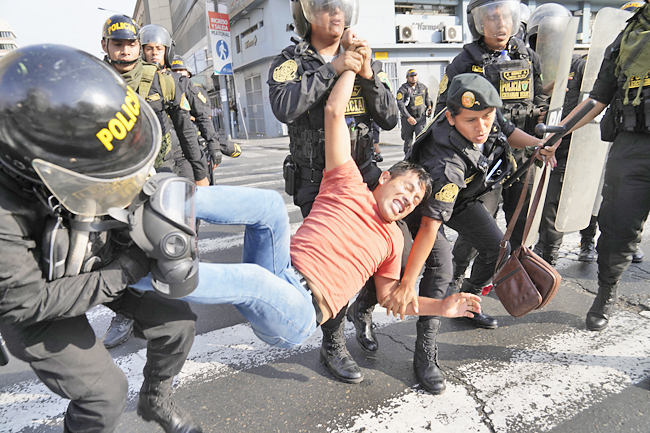LIMA, PERU (AP) – Thousands of protesters demanding the ouster of President Dina Boluarte poured into Peru’s capital, clashing with police who fired tear gas. Many came from remote regions, where dozens have died in unrest that has gripped the country since Peru’s first leader from a rural Andean background was removed from office last month.
The protests have been marked by Peru’s worst political violence in more than two decades and highlighted deep divisions between the country’s urban elite, largely concentrated in Lima, and poor rural areas. Former president Pedro Castillo has been in detention and is expected to be tried for rebellion since he was impeached after a failed attempt to dissolve Congress.
Thursday was mostly quiet, but punctuated by scuffles and tear gas. The government called on everyone who could to work from home. After sundown, clashes escalated, and late that night, a major fire broke out at a building near the historic Plaza San Martin, although no connection to the protests was immediately clear.
Anger at Boluarte was the common thread on Thursday as protesters chanted calls for her resignation and street sellers hawked T-shirts saying, “Out, Dina Boluarte”, “Dina murderer, Peru repudiates you”, and “New elections, let them all leave”.
Peru’s ombudsman said at least 13 civilians and four police officers were injured in the Lima protests on Thursday.
A total of 22 police officers and 16 civilians were injured on Thursday throughout the country, Interior Minister Vicente Romero Fernández said.

Protesters blamed Boluarte for the violence. Many Lima residents also joined yesterday’s protests, with strong presences from students and union members.
“We’re at a breaking point between dictatorship and democracy,” said Pedro Mamani, a student at the National University of San Marcos, where demonstrators who travelled for the protest were being housed.
The university was surrounded by police officers, who also deployed at key points of Lima’s historic downtown district – 11,800 officers in all, according to Victor Zanabria, the head of the Lima police force.
Boluarte was defiant on Thursday night in a televised speech alongside key government officials in which she thanked police for controlling the “violent protests” and vowed to prosecute those responsible for violence. Boluarte has said she supports a plan to hold elections for president and Congress in 2024, two years before originally scheduled.
The president also criticised the protesters for “not having any kind of social agenda that the country needs,” accused them of “wanting to break the rule of law” and raised questions about their financing.
For much of the day, the protests played out as a cat-and-mouse game, with demonstrators, some of whom threw rocks at law enforcement, trying to get through police lines and officers responding with volleys of tear gas that sent protesters fleeing, using rags dipped in vinegar to alleviate the sting to their eyes and skin.
“We’re surrounded,” said Sofia López, 42, as she sat on a bench outside the country’s Supreme Court. “We’ve tried going through numerous places and we end up going around in circles.” Lopez came from Carabayllo, around 35 kilometres north of the capital.
By early afternoon, protests had turned key roads into large pedestrian areas in downtown Lima.
There was visible frustration among the protesters, who had hoped to march to the Miraflores district, an emblematic neighbourhood of the economic elite eight kilometres from downtown.
In a Miraflores park, a large police presence separated anti-government protesters from a small group of demonstrators expressing support for law enforcement. Police fired tear gas there as well to disperse demonstrators.
By bringing the protest to Lima, demonstrators hoped to give fresh weight to the movement that began when Boluarte was sworn into office on December 7 to replace Castillo. “When there are tragedies, bloodbaths outside the capital it doesn’t have the same political relevance in the public agenda than if it took place in the capital,” said Alonso Cárdenas, a public policy professor at the Antonio Ruiz de Montoya University in Lima.
Protests were also held elsewhere and video posted on social media showed demonstrators trying to storm the airport in southern Arequipa, Peru’s second city. They were blocked by police and one person was killed in the ensuing clashes, Peru’s ombudsman said.
That was one of three airports that suffered attacks from protesters on Thursday, Boluarte said, adding it wasn’t “a mere coincidence” they were stormed on the same day.





